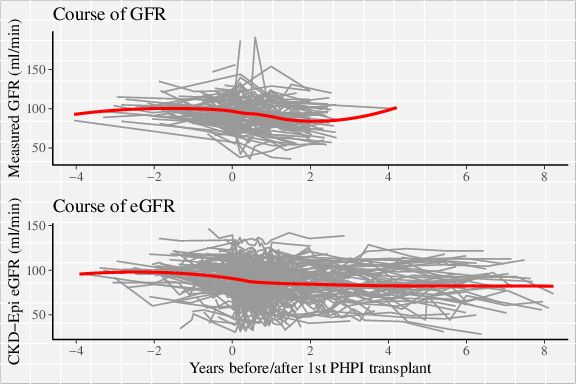Long Term Renal Function Following Islet Transplantation in the Clinical Islet Transplantation Consortium
1Internal Medicine, U. Iowa, Iowa City, IA, 2NIDDK/NIH, Bethesda, MD, 3Internal Medicine, U. Pennsylvania, Philadelphia, PA, 4Internal Medicine, University of Iowa, Iowa City, IA
Meeting: 2019 American Transplant Congress
Abstract number: 624
Keywords: Calcineurin, Glomerular filtration rate (GFR), Islets, Renal function
Session Information
Session Time: 8:30am-10:00am
 Presentation Time: 9:30am-9:45am
Presentation Time: 9:30am-9:45am
Location: Veterans Auditorium
*Purpose: Islet transplantation (IsletTp) is safe and effective treatment of Type 1 diabetes complicated by severe hypoglycemia (Diabetes Care 2016, 39:1230). But the requirement for calcineurin inhibitor (CNI) based immunosuppression raises concern about possible long term adverse effects of CNI on recipient renal function. We report the analysis of GFR and eGFR in 128 subjects in 8 CIT protocols.
*Methods: Glomerular filtration rate (GFR) and estimated GFR (eGFR) were assessed during 7 CIT 1-3 year studies; eGFR was also measured for up to 8 years in a study (CIT-08) of subjects completing the main studies. GFR was measured by plasma clearance of iohexol. eGFR was assessed from serum creatinine (Scr) values using the CKD-Epi formula. GFR and eGFR measured on the same day agreed closely. Average and individual GFR and eGFR intercepts and slopes following IsletTp were assessed using Bayesian hierarchical repeated measures analysis. The impact of IsletTp on renal function was analyzed as the step drop from baseline to the time 0 intercept and subsequent long-term slope.
*Results: The figure shows in grey the GFR and eGFR of each CIT subject over follow-up. The red curves show a smoothed average of GFR and eGFR over follow-up time.
Average GFR and eGFR drop for the first 1 – 1.5 years following IsletTp, but then stabilize, seen especially in the longer-term follow-up of eGFR. The table shows estimated average post-transplant drops in GFR and eGFR and their subsequent slopes.
The median drops of GFR and eGFR from pre- to post-IsletTp were similar. The median post-IsletTp GFR slope, based on the first two years post-IsletTp, was -3.95 (MAD 0.37). But the eGFR slope based on up to 8 years of follow-up was -0.42 (MAD 1.99), not different from that in the general public. Estimated eGFR slopes of 6 of the 128 CIT subjects (~5%) were < -5 mL/min/year.
*Conclusions: There is little long-term risk of adverse impact of IsletTp and CNI immunosuppression on long term renal function in most CIT subjects. But 5% of IsletTp recipients may experience more serious renal function decline.
To cite this abstract in AMA style:
Hunsicker LG, Eggerman TL, Rickels MR. Long Term Renal Function Following Islet Transplantation in the Clinical Islet Transplantation Consortium [abstract]. Am J Transplant. 2019; 19 (suppl 3). https://atcmeetingabstracts.com/abstract/long-term-renal-function-following-islet-transplantation-in-the-clinical-islet-transplantation-consortium/. Accessed December 21, 2025.« Back to 2019 American Transplant Congress


